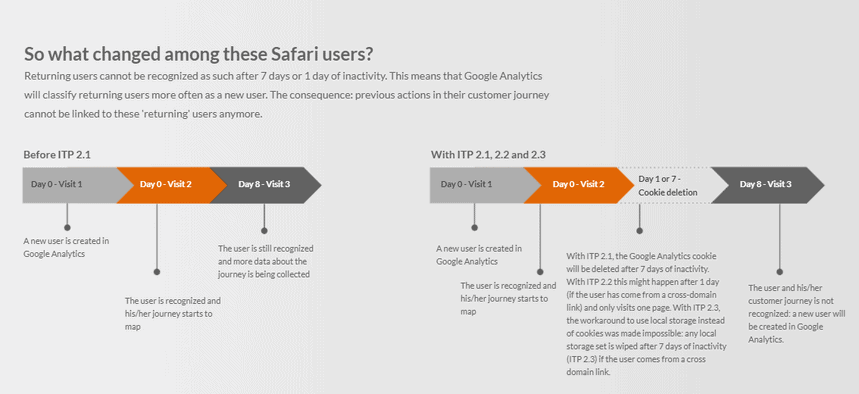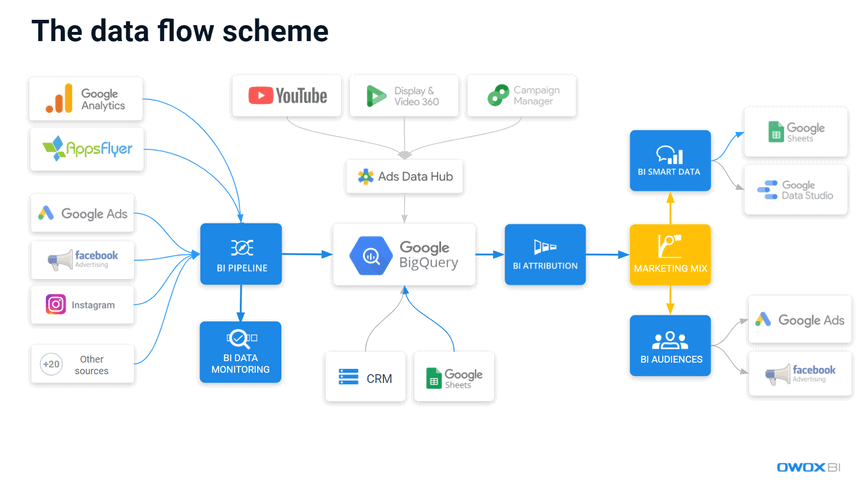Table of contents
The Marketing Wars: the rise of the post-cookie world
Vlada Malysheva, Creative Writer @ OWOX
Remember as, at the beginning of the year (Google announcement from January, 14) the hearts of all marketers stopped beating when news about cookie canceling appeared? Almost a year later, we’ve decided to look back and see what has changed in marketing and how the rejection of cookies has affected the industry as a whole.
There’s been a lot of talk about cookies and the fact that their lifespan will become much shorter than we’re used to. Let’s figure out what innovations await us and how marketers can adapt to the new reality.
What’s going on?
2020 will be remembered not only by quarantine and the massive transition of the business to online. At the beginning of this year, Google announced its planned departure from working with third-party cookies. For newcomers to the industry, let’s clarify that third-party cookies are the crumbs of bread by which marketers know two things:
- where to find Hansel and Gretel in the dark forest of the Internet.
- what Hansel and Gretel want to buy: GPS trackers and offline maps mobile application.
In other words, these are small marketing assistants who help track user behavior and preferences on any platform (desktop, mobile applications). No company doesn’t use third-party cookies in marketing and sales. However, by 2022, the world will abandon its use.
Why did this happen? Because data collection usually occurs without notifying users, which in turn is a direct violation of consumer rights. The Amazon example is very indicative in this case: on December 7, 2020, the company received a lawsuit for 35 million euros for violating the rules for using third-party cookies.
Of course, Google is not the only large company that has changed its use of third-party cookies. Still, it’s its decision that will ultimately change the entire digital economy. Google isn’t for nothing the largest player in the marketing market, and its web browser Chrome remains the most popular browser in the world. Not surprisingly, after Google announced its decision, the entire industry fell into a panic. The well-developed technologies for collecting information about users, on which marketers built a whole ecosystem of digital advertising, suddenly became useless.
However, over the past months, marketers around the world have already passed all five stages of taking the inevitable. For now, they’re at the last phase:
- Taking steps to rebuild their approaches to work.
- Exploring new opportunities (Google Analytics 4).
- Recalling the well-known variants (contextual advertising, etc.).
How cookie changes will affect your business
The consequences can be divided into 3 levels for business, from minor changes to major ones.
Low impact. If you evaluate the effectiveness of advertising campaigns directly in an advertising service (for example, you only use Facebook Ads and don’t use other advertising services), then the impact of the changes will be low and you’ll be able to continue working as before.
Average impact. If you work with covered campaigns in walled gardens (the largest being Google and Facebook), then the impact will be average, because the covered campaigns will be aimed at metrics collected around campaigns and not users and will be available in the advertising account at the segment level.
High impact. If you evaluate advertising campaigns with advanced analytics that combine user activities at different touchpoints, then the impact will be high. In case you use audience segments and cross-device reports, combining user actions before sending them to advertising services, then the impact will be even higher.
How to check how cookie changes will affect you
Orange Valley has prepared a dashboard that helps determine what share of your revenue is at risk. To do this, compare the share of new users in Safari and other browsers. The image below shows that Safari has a 10 percentage point advantage in terms of new users, but we already understand that they aren’t all new: many have simply received a new cookie ID.

What you can do to maintain efficiency of your business
The most important thing is to collect first-party and second-party data:
- First-party data is data that users provide directly to your company in your application or on your website.
- Second-party data is collected by an advertising service and includes data from advertising accounts.
To collect first-party and second-party data, you must first implement a marketing data lake. The data in this data lake must be owned and controlled by you, not by the advertising service. As long as user data is stored in different systems — especially those that don’t belong to you, such as an advertising account or CRM — you can’t analyze any advertising campaign.
Read more about why Google BigQuery as a data lake is the best choice for marketing.
You can collect raw user activity data from your website and mobile application. Import the most granular data you can get from advertising services into your data lake. Many marketers use only UTM tags for tracking transitions from advertising accounts. But UTM tags aren’t enough without a connection to a specific user.
Motivate users to log in to your website and application. Logging in is an underestimated activity that allows you to collect data on a user without IDFA or cookies, use your own identifier, and track the user across platforms.
Useful tips
- If you’re looking for a convenient connector for transferring data to Google BigQuery, we recommend OWOX BI Pipeline. It combines data from Google Analytics, advertising services, websites, offline stores, call tracking systems, and CRM systems into Google BigQuery.
- If you want to build reports based on Google BigQuery data in your favorite Google Sheets or you want to transfer data from Google Sheets to Google BigQuery, we recommend using the free and convenient OWOX BI BigQuery Reports add-on.
The BigQuery Reports add-on is popular for many reasons:
- It’s free, safe, and secure
- It doesn’t require you to upload data as CSV files or use paid third-party services
- It uses only Google’s official APIs
You can find more details about this OWOX BI add-on here.
Alternatives to work with without cookies
In the new realities, we must, first of all, remember about the end-user and respect the user’s privacy. It’s worth noting here that third-party cookies weren’t designed, considering these moments.
Secondly, you should also not forget that mobile devices occupy more and more positions. And here, device IDs and SDK data come to the help of a marketer in obtaining necessary information about the user. By the way, according to a 2020 report by GlobalWebIndex, consumers are increasingly using smartphones to find, buy, and pay for products and services.

To monitor the effectiveness of advertising campaigns, Google offers the Ads Data Hub, which consolidates all advertising campaign information available to Google and makes it available for analysis by the advertiser. However, Ads Data Hub doesn’t allow for downloading reports at the user level.
Apple’s SKAdNetwork tool also allows you to assess the effectiveness of advertising campaigns — but not at the user level. If an advertising service is connected to this platform, you can send conversions and signals from a mobile application, from which you can assess the value of a campaign and interactions between the advertising campaign and users. There are many more restrictions — for example, only up to 100 advertising campaigns per account — and breaking down these campaigns to track a particular user isn’t possible.
For example, if you use the OWOX BI service to collect data from a mobile application (AppsFlyer) and your website (Google Analytics), that’s how your data movement can look like.
You can use Ads Data Hub as a tool for combining data on advertising campaigns, collect data from other advertising services, and add data from your CRM to build reports and attribution models.

What consequences await marketers in the near future
Given the changes in the market and taking into account future forecasts, our experts suggest that shortly marketers will have to face the following: the increase in the following metrics and parameters:
- The share of new users.
- The share of direct traffic.
- The role of associated conversions in the evaluation of campaigns.
At the same time, there will be a decrease in such parameters as:
- The length of the conversion chain.
- Cohort reports will be significantly limited.
- The quality of attribution.
In addition, there is a high probability that:
- The cost of attracting clients will increase. This will happen first of all because advertising services will have less information with which to target ads. And the less opportunity an advertising service has to determine that an offer or creative is in the user’s interest, the less relevant it will be: CTR will decrease and CPA will increase.
- Small players will leave the market. Large advertising services can afford associated conversions as an argument for how their campaigns drive advertisers’ sales, but the small players can’t afford this method.
Key takeaways
A fragmented user path to conversion and new initiatives to protect sensitive information requires entirely new approaches to obtain the data marketers need. Only one thing can be clearly stated — first-party data should prevail in your data analysis.
To get more first-party data directly from users, you should think about how to convince your customers to share this information with you. For example, you can use loyalty programs to offer personalized discounts. With this approach, your customers will see value in sharing personal information with you.
And, of course, think about how you will store and process the extracted data. After all, if the data doesn’t work for you, why are you spending money to collect it? If you don’t know where to start, sign up for a demo with our specialists. Our team will help you prepare for the transition to a new post-cookie world.
Prepare for the future!
Schedule a session now to adapt to the new landscape.
FAQ
-
What are some strategies for adapting to a post-cookie world?
Some strategies for adapting to a post-cookie world include focusing on first-party data collection and usage, investing in contextual advertising solutions, and exploring new technologies like artificial intelligence and machine learning for audience targeting. -
How will the shift to a post-cookie world impact the advertising industry?
The shift to a post-cookie world will require advertisers to find new ways to target and reach audiences, such as through first-party data and contextual advertising. It may also result in changes to the overall digital advertising landscape and the relative power of different players in the industry. -
Why is the move to a post-cookie world happening?
The move to a post-cookie world is happening due to concerns about consumer privacy and data protection, as well as changes made by web browsers and operating systems to limit the use of cookies.











